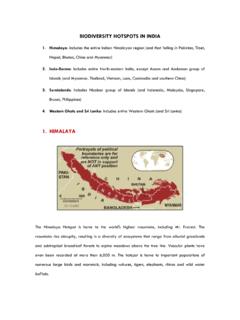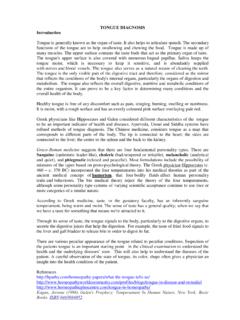Transcription of BIODIVERSITY HOTSPOTS IN INDIA
1 BIODIVERSITY HOTSPOTS IN INDIA 1. Himalaya: Includes the entire Indian Himalayan region (and that falling in Pakistan, Tibet, Nepal, Bhutan, China and Myanmar) 2. Indo-Burma: Includes entire North-eastern INDIA , except Assam and Andaman group of Islands (and Myanmar, Thailand, Vietnam, Laos, Cambodia and southern China) 3. Sundalands: Includes Nicobar group of Islands (and Indonesia, Malaysia, Singapore, Brunei, Philippines) 4. Western Ghats and Sri Lanka: Includes entire Western Ghats (and Sri Lanka) 1.
2 HIMALAYA The Himalaya Hotspot is home to the world's highest mountains, including Mt. Everest. The mountains rise abruptly, resulting in a diversity of ecosystems that range from alluvial grasslands and subtropical broadleaf forests to alpine meadows above the tree line. Vascular plants have even been recorded at more than 6,000 m. The hotspot is home to important populations of numerous large birds and mammals, including vultures, tigers, elephants, rhinos and wild water buffalo.
3 VITAL SIGNS Hotspot Original Extent (km ) 741,706 Hotspot Vegetation Remaining (km ) 185,427 Endemic Plant Species 3,160 Endemic Threatened Birds 8 Endemic Threatened Mammals 4 Endemic Threatened Amphibians 4 Extinct Species 0 Human Population Density (people/km ) 123 Area Protected (km ) 112,578 Area Protected (km ) in Categories I-IV* 77,739 Recorded extinctions since 1500. *Categories I IV afford higher levels of protection OVERVIEW Stretching in an arc over 3,000 kilometers of northern Pakistan, Nepal, Bhutan and the northwestern and northeastern states of INDIA , the Himalaya hotspot includes all of the world's mountain peaks higher than 8,000 meters.
4 This includes the world s highest mountain, Sagarmatha (Mt. Everest) as well as several of the world s deepest river gorges. This immense mountain range, which covers nearly 750,000 km , has been divided into two regions: the Eastern Himalaya, which covers parts of Nepal, Bhutan, the northeast Indian states of West Bengal, Sikkim, Assam, and Arunachal Pradesh, southeast Tibet (Autonomous Region of China), and northern Myanmar; and the Western Himalaya, covering the Kumaon-Garhwal, northwest Kashmir, and northern Pakistan.
5 While these divisions are largely artificial, the deep defile carved by the antecedent Kali Gandaki River between the Annapurna and Dhaulagiri mountains has been an effective dispersal barrier to many species. The abrupt rise of the Himalayan Mountains from less than 500 m to more than 8,000 m results in a diversity of ecosystems that range, in only a couple of hundred kilometers, from alluvial grasslands (among the tallest in the world) and subtropical broadleaf forests along the foothills to temperate broadleaf forests in the mid hills, mixed conifer and conifer forests in the higher hills, and alpine meadows above the tree line.
6 SPECIES DIVERSITY AND ENDEMISM Taxonomic Group Species Endemic Species Endemism (%) Plants 10,000 3,160 Mammals 300 12 Birds 977 15 Reptiles 176 48 Amphibians 105 42 Freshwater Fishes 269 33 Biogeographically, the Himalayan Mountain Range straddles a transition zone between the Palearctic and Indo-Malayan realms. Species from both realms are represented in the hotspot. In addition, geological, climatic and altitudinal variations in the hotspot, as well as topographic complexity, contribute to the biological diversity of the mountains along their east-west and north-south axes.
7 PLANTS Of the estimated 10,000 species of plants in the Himalaya hotspot, about 3,160 are endemic, as are 71 genera. Furthermore, five plant families are endemic to the region, the Tetracentraceae, Hamamelidaceae, Circaesteraceae, Butomaceae and Stachyuraceae. The largest family of flowering plants in the hotspot is the Orchidacea, with 750 species, and a large number of orchids, many representing rather young endemic species, have recently been reported from the hotspot, indicating that further exploration will probably reveal a much higher degree of plant endemism.
8 The Eastern Himalaya is also a center of diversity for several widely distributed plant taxa, such as Rhododendron, Primula, and Pedicularis. In the Himalaya Hotspot, a zone of permanent rock and ice begins at about 5,500 6,000 m; in spite of these harsh conditions, there are records of vascular plants occurring at some of the highest elevations on Earth. Cushion plants have been recorded at more than 6,100 m, while a high-altitude scree plant in the mustard family, Ermania himalayensis, was found at 6,300 m on the slopes of Mt.
9 Kamet in the northwestern Himalayas. THREATS Human Impacts Despite their apparent remoteness and inaccessibility, the Himalayas have not been spared human-induced BIODIVERSITY loss. People have lived in the mountains of the Himalayas for thousands of years. In recent decades, greater access to the global market has increased the demand for natural resources in the area encouraged both immigration from outside (such as Arunachal Pradesh) and movement within the region (such as in Nepal).
10 As a result, populations are growing in the most productive ecosystems, which are also some of the richest in BIODIVERSITY . Today, remaining habitat in the Himalaya is patchy. The steadily increasing population in the hotspot has led to extensive clearing of forests and grasslands for cultivation, and widespread logging. Both legal and illegal logging often occurs on extremely steep slopes, resulting in severe erosion. Although cultivation has a general upper limit of about 2,100 m on slopes exposed to monsoons, people farm crops such as barley, potato and buckwheat at high elevations in the inner valleys and trans-montane regions, and in some areas such as Jumla, Kashmir, Lahoul, and Ladakh, there are major agriculturally based population centers well above this elevation.





